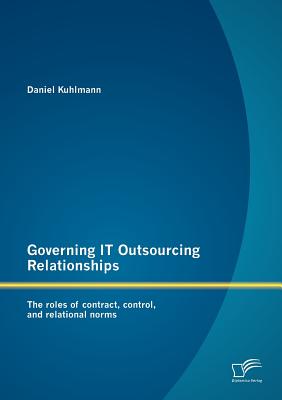
Governing IT Outsourcing Relationships: The roles of contract, control, and relational norms
Paperback
ISBN13: 9783842879539
Publisher: Diplomica Verlag
Published: Aug 22 2012
Pages: 140
Weight: 0.39
Height: 0.30 Width: 5.83 Depth: 8.27
Language: English
Also in
Business General
The Let Them Theory: A Life-Changing Tool That Millions of People Can't Stop Talking about
Robbins, Mel
Robbins, Sawyer
Hardcover
The Unity of the Capitalist Economy and State: A Systematic-Dialectical Exposition of the Capitalist System
Reuten, Geert
Paperback
This Program Is Brought to You by . . .: Distributing Television News Online
Braun, Joshua A.
Paperback
Hbr's 10 Must Reads on Mental Toughness (with Bonus Interview Post-Traumatic Growth and Building Resilience with Martin Seligman) (Hbr's 10 Must Reads
Review, Harvard Business
Schwartz, Tony
Seligman, Martin E. P.
Paperback
I Will Teach You to Be Rich: No Guilt. No Excuses. Just a 6-Week Program That Works (Second Edition)
Sethi, Ramit
Paperback
Main Street Millionaire: How to Make Extraordinary Wealth Buying Ordinary Businesses
Sanchez, Codie
Hardcover
Unicorn Team: The Nine Leadership Types You Need to Launch Your Big Ideas with Speed and Success
Kem, Jen
Hardcover
Unreasonable Hospitality: The Remarkable Power of Giving People More Than They Expect
Guidara, Will
Hardcover
The Year in Tech, 2025: The Insights You Need from Harvard Business Review
Webb, Amy
Farri, Elisa
Review, Harvard Business
Paperback
Hbr's 10 Must Reads on High Performance (with Bonus Article the Right Way to Form New Habits" an Interview with James Clear)
Clear, James
Goleman, Daniel
Review, Harvard Business
Paperback
Rocket Fuel: The One Essential Combination That Will Get You More of What You Want from Your Business
Wickman, Gino
Winters, Mark C.
Paperback
Covet the Comeback: How a Son of Greek Immigrants Found Success, Lost Everything, Then Built a Fashion Empire
Garkinos, Christos
Paperback
Crucial Conversations: Tools for Talking When Stakes Are High
Patterson, Kerry
Grenny, Joseph
McMillan, Ron
Paperback
The Daily Stoic: 366 Meditations on Wisdom, Perseverance, and the Art of Living
Holiday, Ryan
Hanselman, Stephen
Hardcover
The Goal: 40th Anniversary Edition: A Process of Ongoing Improvement
Cox, Jeff
Goldratt, Eliyahu M.
Paperback
Hábitos Atómicos: Cambios Pequeños, Resultados Extraordinarios / Atomic Habits
Clear, James
Paperback
The Millionaire Master Plan: Your Personalized Path to Financial Success
Hamilton, Roger James
Hardcover
Confidence (HBR Emotional Intelligence Series)
Chamorro-Premuzic, Tomas
Review, Harvard Business
Kanter, Rosabeth Moss
Paperback
Influence and Persuasion (HBR Emotional Intelligence Series)
Cialdini, Robert B.
Review, Harvard Business
Morgan, Nick
Paperback
A Guide to the Project Management Body of Knowledge and the Standard for Project Management
Project Management Institute
Paperback
Beyond the Hammer: A Fresh Approach to Leadership, Culture, and Building High Performance Teams
Gottlieb, Brian
Hardcover
Expecting Better: Why the Conventional Pregnancy Wisdom Is Wrong--And What You Really Need to Know
Oster, Emily
Paperback
The Reset Mindset: Get Unstuck, Focus on What Matters Most, and Reach Your Goals Faster
Zenker, Penny
Hardcover
Never Split the Difference: Negotiating as If Your Life Depended on It
Raz, Tahl
Voss, Chris
Hardcover
Mindful Listening (HBR Emotional Intelligence Series)
Review, Harvard Business
Hougaard, Rasmus
Zenger, Jack
Paperback
Hbr's 10 Must Reads on Managing Yourself (with Bonus Article How Will You Measure Your Life? by Clayton M. Christensen)
Christensen, Clayton M.
Review, Harvard Business
Drucker, Peter F.
Paperback
The Millionaire Fastlane: Crack the Code to Wealth and Live Rich for a Lifetime!
DeMarco, M. J.
Paperback
Happiness (HBR Emotional Intelligence Series)
McKee, Annie
Gilbert, Daniel
Review, Harvard Business
Paperback
You Deserve to Be Rich: Master the Inner Game of Wealth and Claim Your Future
Millings, Troy
Bilal, Rashad
Hardcover
Power and Impact (HBR Emotional Intelligence Series)
Bregman, Peter
Review, Harvard Business
Cable, Dan
Paperback
Mindfulness (HBR Emotional Intelligence Series)
Review, Harvard Business
Langer, Ellen
Goleman, Daniel
Paperback
The Technological Republic: Hard Power, Soft Belief, and the Future of the West
Zamiska, Nicholas W.
Karp, Alexander C.
Hardcover
Atlas of the Heart: Mapping Meaningful Connection and the Language of Human Experience
Brown, Brené
Hardcover
Why a Students Work for C Students and Why B Students Work for the Government: Rich Dad's Guide to Financial Education for Parents
Kiyosaki, Robert T.
Paperback
Hbr's 10 Must Reads on Emotional Intelligence (with Featured Article What Makes a Leader? by Daniel Goleman)(Hbr's 10 Must Reads)
Goleman, Daniel
Boyatzis, Richard E.
Review, Harvard Business
Hardcover
The Power Pause: How to Plan a Career Break After Kids--And Come Back Stronger Than Ever
Ruch, Neha
Hardcover
Cribsheet: A Data-Driven Guide to Better, More Relaxed Parenting, from Birth to Preschool
Oster, Emily
Paperback
The Obstacle Is the Way Expanded 10th Anniversary Edition: The Timeless Art of Turning Trials Into Triumph
Holiday, Ryan
Hardcover
When Women Ran Fifth Avenue: Glamour and Power at the Dawn of American Fashion
Satow, Julie
Hardcover
Who Moved My Cheese?: An A-Mazing Way to Deal with Change in Your Work and in Your Life
Johnson, Spencer
Hardcover
Get Scalable: The Operating System Your Business Needs To Run and Scale Without You
Deiss, Ryan
Paperback
From the Battlefield To the Boardroom: The Infinite Desire to Win - A Woman's Journey To Infinite Success in Life, Business, and Career
Stribling, Sonja y.
Hardcover
The Mushroom at the End of the World: On the Possibility of Life in Capitalist Ruins
Tsing, Anna Lowenhaupt
Paperback
The Energy Bus: 10 Rules to Fuel Your Life, Work, and Team with Positive Energy
Gordon, Jon
Hardcover
Positive Intelligence: Why Only 20% of Teams and Individuals Achieve Their True Potential and How You Can Achieve Yours
Chamine, Shirzad
Hardcover
The New Gold Standard: 5 Leadership Principles for Creating a Legendary Customer Experience Courtesy of the Ritz-Carlton Hotel Company
Michelli, Joseph A.
Hardcover
The Millionaire Next Door: The Surprising Secrets of America's Wealthy
Danko, William D.
Stanley, Thomas J.
Paperback
Can't Deny It - An Unlikely Wall Street Career and the Calls that Reshaped the Energy Industry
Terreson, Doug
Hardcover
The Coaching Habit: Say Less, Ask More, and Change the Way You Lead Forever
Stanier, Michael Bungay
Paperback
Fire in the Hole!: The Untold Story of My Traumatic Life and Explosive Success
Parsons, Bob
Hardcover
Getting to Yes: Negotiating Agreement Without Giving in
Ury, William
Patton, Bruce
Fisher, Roger
Paperback
Predictable Revenue: Turn Your Business Into a Sales Machine with the $100 Million Best Practices of Salesforce.com
Tyler, Marylou
Ross, Aaron
Paperback
Hbr's 10 Must Reads on Strengthening Your Soft Skills (with Bonus Article You Don't Need Just One Leadership Voice--You Need Many by Amy Jen Su)
Goleman, Daniel
Gallo, Amy
Review, Harvard Business
Paperback
The Leadership Challenge: How to Make Extraordinary Things Happen in Organizations
Kouzes, James M.
Posner, Barry Z.
Hardcover
The 360 Degree Leader: Developing Your Influence from Anywhere in the Organization
Maxwell, John C.
Paperback
Effective Phrases for Performance Appraisals: A Guide to Successful Evaluations
Neal Jr, James E.
Paperback
The Strategic Millionaire: Seven Laws Of Wealth The Rich Don't Tell You
Pantoja, Armando J.
Paperback
Demand-Side Sales 101: Stop Selling and Help Your Customers Make Progress
Moesta, Bob
Engle, Greg
Hardcover
Scaling Up (Revised 2022): How a Few Companies Make It...and Why the Rest Don't (Rockefeller Habits 2.0)
Harnish, Verne
Paperback
It's Not Hysteria: Everything You Need to Know about Your Reproductive Health (But Were Never Told)
Tang, Karen
Hardcover
El Dinero No Es El Problema, Tú Lo Eres - Money is Not the Problem Spanish
Douglas, Gary M.
Heer, Dain
Paperback
The Daily Laws: 366 Meditations on Power, Seduction, Mastery, Strategy, and Human Nature
Greene, Robert
Paperback
The Mom Test: How to talk to customers & learn if your business is a good idea when everyone is lying to you
Fitzpatrick, Rob
Paperback
Play a Bigger Game: Seven Universal Principles to Experience True Fulfillment and Win at Life
Kaulius, Markus
Hardcover
Speak Goodr: Confessions of a Professional Speaker on Mastering Public Speaking and Getting Paid to Speak
Vet, Ryan C.
Hardcover
Covet the Comeback: How a Son of Greek Immigrants Found Success, Lost Everything, Then Built a Fashion Empire
Garkinos, Christos
Hardcover
The Language of Trust: Selling Ideas in a World of Skeptics
Maslansky, Michael
West, Scott
DeMoss, Gary
Paperback
Continuous Discovery Habits: Discover Products that Create Customer Value and Business Value
Torres, Teresa
Paperback
The 5 Second Rule: Transform Your Life, Work, and Confidence with Everyday Courage
Robbins, Mel
Hardcover
The One Thing: The Surprisingly Simple Truth about Extraordinary Results
Keller, Gary
Papasan, Jay
Hardcover
Software as a Science: Unlock Limitless Recurring Revenue Without Losing Control
Page, Johnny
Verlaque, Matt
Martell, Dan
Hardcover
Resilience (HBR Emotional Intelligence Series)
Review, Harvard Business
Goleman, Daniel
Sonnenfeld, Jeffrey A.
Paperback
Irreplaceable: The Art of Standing Out in the Age of Artificial Intelligence
Bornet, Pascal
Hardcover
Feedback That Works: How to Build and Deliver Your Message, Second Edition
Center for Creative Leadership
Paperback
Rising Strong: How the Ability to Reset Transforms the Way We Live, Love, Parent, and Lead
Brown, Brené
Paperback


 Sign-In
Sign-In Cart
Cart